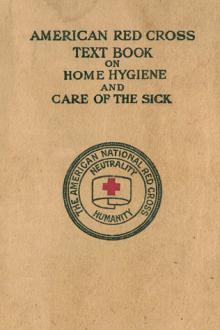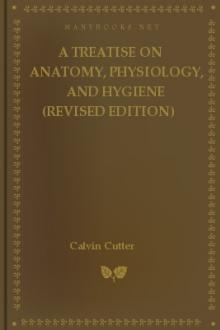American Red Cross Text-Book on Home Hygiene and Care of the Sick by Isabel McIsaac (best affordable ebook reader txt) 📕

- Author: Isabel McIsaac
- Performer: -
Book online «American Red Cross Text-Book on Home Hygiene and Care of the Sick by Isabel McIsaac (best affordable ebook reader txt) 📕». Author Isabel McIsaac
—A satisfactory way to disinfect towels, night gowns, bed linen, etc. is to place the articles immediately in a wash boiler filled with cold water to which a little washing soda has been added, and then to boil them in the same water for twenty minutes; they can afterward go safely into the regular laundry. The boiling may be done once a day; articles soiled in the meantime may be left to soak in the cold water and soda.
—"The cleansing and disinfection of the person includes washing the entire body and the hair with soap and water; thorough brushing of the teeth; rinsing the mouth; gargling the throat, and douching and spraying the nose with an antiseptic solution; and finally, a complete change of clothing (or a change of underwear) and a thorough shaking and brushing of the outer garments out-of-doors before these are put on again."—(New York State Department of Health.)
—After the patient has recovered, he and the attendant should, if the doctor thinks it necessary, disinfect themselves as directed above before they mingle again with other people. The exact time when it is safe for a person to come out of quarantine and resume ordinary life varies in different diseases. Moreover, opinion differs in regard to quarantine periods for the same diseases, so that the regulations of Boards of Health in different cities show wide variations. It is of course impossible to say at just what moment every patient, or even the majority of patients, will stop expelling germs. Quarantine periods are intended to protect the community as completely as possible without causing unnecessary hardship to individuals. In any given case, the local regulations should be strictly observed but release from quarantine is not a guarantee that the patient is not still discharging germs, and extreme care should still be taken to prevent the spread of saliva and other discharges.
—A room that has been occupied by a patient with a communicable disease should be thoroughly cleaned at the termination of the illness. Dishes, utensils, bed linen, etc. should be cared for in the ways already described. The floor, bedstead, and other furniture should be washed with hot water, soap, and washing soda. The walls, windows, etc., should be wiped with a cloth wrung out of hot water, soap suds, and soda. The mattress, unless badly soiled with discharges, should be scrubbed with the same solution and a stiff brush, and left out-of-doors in the sunshine for a day or two, or until dry. If badly soiled, it is best to destroy the mattress unless the Board of Health has facilities for steam sterilization. Ordinary washing is all that is generally required for blankets, but if badly soiled they should be sterilized by steam or burned. The room should then be thoroughly sunned and aired for a day or two, with the windows wide open both day and night. Sunning and airing are among the most important measures in disinfecting a room, and should not be slighted. If there has been gross pollution, as when a careless consumptive persists in spitting on the floor and walls, it may be necessary to remove the old paint and paper and have the room done over. The room may safely be occupied after all these measures have been taken.
—Many Boards of Health have abandoned fumigation after communicable diseases, except after those which like typhus and yellow fever, are carried by vermin or insects. Dry formaldehyde gas, which was formerly used for fumigation, has a violent effect on mucous membranes, but its power to kill bacteria, even on surfaces, appears to be weak, while its penetrating power is not sufficient to disinfect bedding, carpets, upholstered furniture, and other fabrics. Since fumigation is costly, troublesome, and ineffectual there seems to be no good reason for using it. Moreover, its use gives a false sense of security, so that really effective measures like sunning, airing, and scrubbing are likely to be neglected.
Theory and practice of disinfection, it is clear, have radically changed in recent years. Modern knowledge requires concurrent disinfection, or the destruction of germs from the moment when symptoms are first noticed; all the time, day and night, this disinfection must go on with unremitting care. Today wet sheets are not hung in doorways nor are chemicals left about in open dishes to disinfect quite harmless air, but scrupulous cleanliness at all stages of disease is recognized as one of the most important measures, if not the most important measure, in disinfection.
EXERCISES Summarize the ways in which infectious diseases are spread. What is meant by the incubation period? State the length of the incubation period in measles; Liberty measles; whooping-cough; scarlet fever; chicken-pox; diphtheria; mumps; typhoid fever. Name some of the early symptoms common to most infectious diseases. If such symptoms appear, what should be done while waiting for the doctor to come? Discuss the importance, prevention, and treatment of common colds. What measures should be taken to isolate a patient who is suffering from a communicable disease? What special care should the attendant of a patient with a communicable disease give to her own clothing and person? Why are the children's diseases more serious in reality than they are commonly supposed to be? Describe the symptoms of each of the following: Measles, scarlet fever, chicken-pox, mumps, whooping-cough, and diphtheria. How should bowel and bladder discharges be disinfected? How should dishes and other utensils be disinfected? How should linen be disinfected? Describe measures necessary for concurrent disinfection. Describe measures necessary for terminal disinfection. FOR FURTHER READING Preventive Medicine and Hygiene—Rosenau. The New Public Health—Hill, Chapters VII-XVII. Essentials of Medicine—Emerson, Chapters XII-XV. Health and Disease—Roger I. Lee, Chapter X-XIV. Disease and Its Causes—Councilman, Chapters V-IX. Publications of the New York State Department of Health, Albany, entitled: The Teacher and Communicable Disease; A Method for the Control of Communicable Diseases in Schools; Regulations and Instructions for Cleansing and Disinfection; The Conduct of an Isolation Period for Communicable Disease in a Home; Tuberculosis; Typhoid Fever; Scarlet Fever; Measles; Whooping-cough; Diphtheria; Poliomyelitis, Acute Anterior (Infantile Paralysis); Smallpox; Septic Sore Throat; Venereal Diseases. (Any of the above pamphlets will be sent upon receipt of a three cent stamp.) CHAPTER XIIICOMMON AILMENTS AND EMERGENCIES
This chapter describes a few home treatments for the relief of slight ailments and injuries, together with some measures that may be employed in emergencies. For more extended instructions in these subjects the student should consult the Red Cross Text-book on First Aid.
CONDITIONS IN WHICH THE NERVOUS SYSTEM IS INVOLVED—Headache is not a disease in itself, but a symptom common to many different disorders. Among the abnormal conditions often causing headaches are fatigue, eyestrain, indigestion, constipation, neuralgia, rheumatism, anæmia, acute infections, and other disorders. Treatment should consist in finding the cause and removing it if possible; clearly no one remedy can cure so many different causes. A physician should be consulted if headaches are of frequent occurrence, but in many cases rest and attention to other hygienic requirements are all that is needed. During an attack of headache a hot foot bath may give relief, or a mustard paste or cold applications on the back of the neck, or an ice bag or cold compress on the forehead.
, like headache, has many possible causes, and effective treatment consists in finding and removing them. Pain or discomfort of any kind, fatigue, overwork, and worry are common causes. Sleeplessness easily becomes a habit that may persist after its cause has been removed; hence a person who has formed the habit of sleeplessness should patiently strive to break the old habit and to substitute a better. A careful hygienic régime is essential for the patient, exercise in the open air, and cultivation of a hopeful and tranquil spirit. The diet should be liberal, but light and unstimulating; tea and coffee should be omitted, certainly during the latter part of the day. The patient should spend rather a dull evening, avoiding excitement and mental exertion that is difficult, even though pleasurable. He should retire early. A hot tub or foot bath, and a hot drink at bed time may help to produce sleep. The bedroom should be dark, cool, and well ventilated, the bed comfortable and the covers light but warm. The patient should be told that rest is the most important thing for him, and that he should not try too hard to sleep nor worry if unsuccessful. The patient should try to banish from his mind, at bed time, thoughts that are distressing, and even those that are especially interesting. By using patience and persistence most persons can regain the power of sleeping even when habits of sleeplessness have been long established.
is a partial or total loss of consciousness due to a diminished supply of blood in the brain. It may follow bleeding, exhaustion from heat, fatigue from prolonged standing and the like, or strong emotional disturbance, like fear or surprise. Fainting is less common than it formerly was; it now occurs most frequently among persons suffering from anæmia, heart weakness, or special susceptibility.
Symptoms of fainting are pale face, cold perspiration, rapid, feeble pulse, and shallow, sighing respiration. Treatment consists in removing the patient into cool, fresh air, applying cold water to the face and keeping the head low. For a person who feels faint but has not lost consciousness, this treatment will probably prove sufficient; if, however, he becomes unconscious, place him so that the head is lower than the body, loosen the clothing, especially the clothing about the neck, apply cold water to the face and chest, and see that fresh air is plentiful. When the patient is sufficiently conscious to swallow, give a teaspoonful of aromatic spirits of ammonia in half a glass of water and keep him quiet until he has entirely recovered.
A person who is unconscious from any cause always requires immediate attention. In emergency work elevate the patient's head if his face is flushed, and keep it low if his face is pale. Do not try to arouse an unconscious patient by shaking him and calling to him, in the first place because it is useless to do so, and in the second, because consciousness will return spontaneously if his condition improves.
—In every case of convulsions a doctor is needed at the earliest possible moment. Convulsions in adults are very serious; in babies and small children although serious they are less alarming, since they may follow comparatively slight disturbances, particularly disturbances of digestion.
Treatment for babies and children with convulsions consists first in keeping the child as quiet as possible, and next in measures to draw blood from the brain toward the surface of the body. The child should first be undressed, moving him as little as possible, and put to bed between warm blankets. Cold should be applied to his head by a compress or ice bag, and hot water bag should be placed near his feet. An enema should





Comments (0)